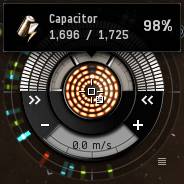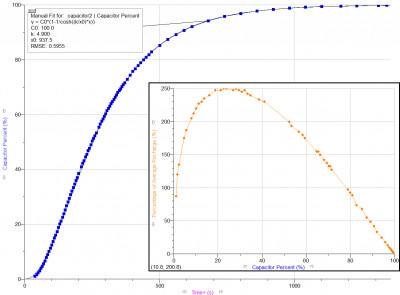Capacitor is an additional energy reserve that your ship uses to power modules and equipments that require a quick burst of power.

Overview
Every ship has an internal generator, and that generator provides the powergrid you see on the fitting window. Modules that are fitted onto the ship will connect to the powergrid and reserve a portion of the generator output for itself (hence reducing the remaining powergrid when fitted). The module will operate using the generator power while you fly your ship.
Some modules, however, need more power to operate. Energy weapons (AKA Laser turrets), for example, need power to shoot a destructive beam at your target. Since the weapon must fire immediately upon being issued a command, it cannot wait until generator power accumulates enough energy for a shot. On the other hand, constantly loading the weapon with full energy required for a shot will waste heaps of powergrid energy and likely melt the weapon itself.
The solution is the Capacitor. The ship's Capacitor permanently leeches a certain amount of generator output to charge itself like a battery - or rather, like a real-life capacitor. When a module requires a quick burst of energy to operate, the capacitor discharges, providing that energy. This way, the capacitor allows your ship to use modules and equipments that require lots of immediate power.
Managing your Capacitor
In the event that your ship is completely drained of capacitor charge, the following will happen:
- You will not have enough energy to initiate warp. (If you only have a partial amount of capacitor charge available, your ship will warp as far as it can go, and stop midway. You can then initiate warp again to arrive at your destination.)
- You will not be able to activate any active modules that require capacitor charge. You still can activate modules that do not.
Being drained of capacitor charge DOES NOT stop your engines or render your ship inoperable.
In the Fitting Simulation window, there is a tab for capacitor charge level simulation.

If a capacitor is "Stable," it means that with every capacitor-consuming module running non-stop, your capacitor energy level will eventually drop down and fluctuate between the percentage level displayed, indefinitely. If a fit's capacitor is stable, it is referred to being "Cap-stable."
If instead the window displays "Depletes in XX:XX," it means that with every capacitor-consuming module running non-stop, your capacitor energy level will drop to 0% after the displayed time.
Next to the orange circle display, four pieces of additional information are displayed. Top row is simply max capacitor capacity and the recharge time. Bottom row is a bit more complicated. The "Delta" (Δ) of your capacitor is (peak capacitor recharge rate) - (Max power consumption rate). Having a positive delta means that your capacitor is stable. Having greater positive delta means that you can afford to be hit with additional capacitor destabilization (most commonly Neutralizers) and still remain stable. Having a negative delta means that your capacitor is not stable. Having greater negative delta means your capacitor depletes faster.
Although it is a good thing to be cap-stable, it is not a requirement. You rarely need everything running at the same time in many PvE situations. Instead of compromising your ship's capability to force it to be cap-stable, you can simply choose to micromanage your module usage to extend the life of your capacitor charge.
- Instead of running a repair module (Shield booster, Armor repairer) non-stop, only activate it when you need to.
- Same goes for propulsion modules, especially Microwarpdrives.
- Keep your capacitor level above 25% at all times. Dropping below 25% drastically reduces your recharge rate.
- When facing against enemies that utilize energy neutralizers or nosferatus, try and keep your distance as to reduce their effectiveness.
- If your ship is lacking in both capacitor stability and tanking ability, try to focus on mitigating damage and eliminating enemy targets quickly instead of brute-forcing through the incoming DPS. Mounting a powerful defence system requires a significant investment, both in terms of Skillpoints and ISK.
Capacitor recharge rate
- The Capacitor passively recharges from onboard generator power and requires no extra "fuel" to replenish.
- Capacitor recharge rate, in Gigajoules per second, is based on the capacitor's capacity, the current capacitor charge, and its recharge time.
- Your capacitor will recharge faster the closer you are to 25% of your maximum.
- The recharge rate drops of very quickly once you go below this.

The capacitor recharge rate is a non-linear function—the rate at any given moment depends on how much energy is stored at that moment. Near zero and near full capacity, the recharge rate is very low, and it peaks at 25 percent.
The important thing to remember is that the recharge rate declines dramatically once it falls below 25% of capacity. Therefore, if in a fight, leave yourself a margin of safety and consider escaping if it appears that you will soon fall below this amount.
A player by the name of “Dust Puppy” investigated the recharge rate in-depth and published his findings[1]. Based on his experiments, he suggests that the formula for calculating recharge rate is:
...where:
- is your current capacitor level in GJ.
- Failed to parse (syntax error): {\displaystyle C_\rm{max}}
is your maximum capacitor level in GJ.
- is your current capacitor recharge rate in GJ/s. (Formally: The instantaneous rate of change of the capacitor charge with respect to time.)
- is capacitor recharge time.
Capacitor recharge, therefore, peaks at 25%, and the advertised “Capacitor Recharge Time” is actually the time for the capacitor to go from dead empty to 98.7%, assuming no drains or boosts.
Experimenting with this formula,[2] it has been found that the peak recharge rate, without any effect of boosters or energy draining weapons, is indeed at 25% of capacitor capacity.
The formula can be also used to write capacitor level as function of time
- Failed to parse (unknown function "\large"): {\displaystyle \displaystyle C_1 = C_{\rm{max}} \left( 1 + e^{ \large 5 \frac{ t_0 -t_1 }{ T } } \left( \sqrt{ \frac{C_0}{C_{\rm{max}}} } - 1 \right) \right)^2 }
where C0 is capacitor level at starting time t0 and C1 is capacitor level at time t1
Capacitor equipment
| High slot modules | |
| Remote Capacitor Transmitter allows a ship to transmit capacitor to a target ship. The target ship will receive more capacitor than the module consumes so in a fleet this module is used to generate more capacitor. | |

|
Energy Nosferatu is an offensive capacitor module. It does not use any capacitor but instead just leeches capacitor from the target ship. |
| Energy Neutralizer is an offensive capacitor module. Activating the module consumes capacitor but the target ship will lose even more capacitor. | |
| Medium slot modules | |
| Cap Battery increases the size of the capacitor pool by a flat ammount. Due to how capacitor recharge rate is calculated this will result in faster capacitor recharge. The module also gives partial resistance against hostile capacitor warfare. | |
| Capacitor Booster allows injecting more capacitor at demand. The module consumes cap booster charges. Each charge gives set ammount of energy. For example Cap Booster 200 will give 200 GJ of energy. | |
| Cap Recharger reduces capacitor recharge time. The result is faster capacitor recharge. | |
| Low slot modules | |
| Capacitor Flux Coil reduces the capacitor pool size and capacitor recharge time. Results in faster capacitor recharge but smaller capacitor size. | |
| Capacitor Power Relay Reduces capacitor recharge time resulting in faster capacitor recharge. But also reduces local shield booster boost ammount. | |
| Power Diagnostic System offers small bonus to capacitor capacity and capacitor recharge time. | |
| Other | |
| |
| |
| Mindflood Booster gives a bonus to capacitor capacity. | |
| Antipharmakon Aeolis gives a bonus to capacitor capacity. | |
Skills
- Direct capacitor related skills:
- Capacitor Management - 5% bonus to capacitor capacity per skill level.
- Capacitor Systems Operation - 5% reduction in capacitor recharge time per skill level.
- Subsystem specific capacitor related skills:
- Afterburner - 5% reduction to Afterburner duration and 10% reduction in Afterburner capacitor use per skill level.
- Capacitor Emission Systems - 5% reduced capacitor need of energy transmitters and energy neutralizers. Only applies to subcapital modules.
- Capital Capacitor Emission Systems - 5% reduced capacitor need of capital energy transmitters and capital energy neutralizers.
- Controlled Bursts - 5% reduction in capacitor need of weapon turrets per skill level.
- Electronic Warfare - 5% less capacitor need for ECM and ECM Burst systems per skill level.
- High Speed Maneuvering - 5% reduction in Microwarpdrive capacitor usage per skill level.
- Jump Drive Operation - 5% reduction in capacitor need of initiating a jump per skill level.
- Propulsion Jamming - 5% Reduction to Warp Scrambler, Warp Disruptor, and Stasis Web capacitor need per skill level.
- Sensor Linking - 5% less capacitor need for sensor link per skill level.
- Warp Drive Operation - 10% reduction in capacitor need of initiating warp per skill level.
- Weapon Disruption - 5% less capacitor need for weapon disruptors per skill level.
